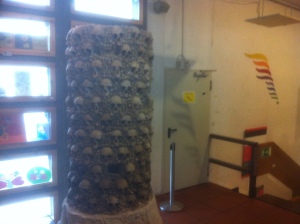20. Feb. 2013
Hello everyone,
in order to design good games, it is important to know the qualities good or even great games possess. I’ve looked at different ones and came up with a list of common traits. Although I have examined and voiced this before, I have not yet written it down. Certainly there are great games that do not have some of these traits and having them will not guarantee that your game is going to be awesome. Still, I’m of the opinion that you’d rather want to include them. I’m going to use the game “Settlers of Catan” as an example.
If you haven’t heard of “Settlers of Catan” and have about half an hour of time to burn, go check out Wil Wheaton’s show tabletop.
I’m going to omit a few details, but basically, Settlers of Catan works like this: The map is randomly generated by placing hexagonal tiles that correspond to different resource types. Somewhat randomly as well, numbers from 2 to 12 are assigned to each tile. Every player starts with two settlements. The objective of the game is to aquire 10 victory points. You score victory points for building things. In order to build new structures, you need resources. When it is your turn, you roll two dice. All the tiles with the number that matches the sum of the dice yield resources for anyone, who has a settlement or city adjacent to it (settlements and cities are always built on corners, so they are adjacent to three hexagonal tiles). Then you can trade with other players, but they may only trade with you and not with each other. After trading, you get to build. If you haven’t won the game, it’s the next person’s turn.
Sounds simple, right? That’s the beauty of Settlers of Catan and of a lot of other great games: They are very easy to understand, allowing a broad section of people to play. Also, reading the rules doesn’t take that long. If there are few and simple rules, the danger of forgetting an important rule, thus invalidating the playing experience, is less pronounced.
In Settlers of Cataan, even if you are walled in by other players’ roads and do not have spots to migrate to, it is still theoretically possible to win, most of the time. Also, even if your chances of winning might be slim, at least you are not out of the action. A lot of the great games have abolished player elimination these days. At the very least, recent games with player elimination like Nexus Ops are designed in such a way that shortly after a player is forced to leave the game, the match ends. Making sure that everyone is sitting at the table, playing the game is very important. It’s just no fun to be kicked out of a game early, just to have everyone else continue for an hour or two.
The resource collection system and barter phase of Catan are a stroke of genius, in my opinion: It’s annoying when you are engaged in a game, but then have to sit around for minutes until it is your turn to play again. In Catan, everyone can receive resources during other people’s turns. Also, you can offer a deal to the player, who rolled the dice. These two mechanics help to reduce the downtime between turns. However, even if you don’t get any new resources and don’t have the necessary stockpile of resources to propose an offer in the barter phase, the individual turns are so short that it’s not as problematic as in other games.
The dreaded “multiplayer solitaire” (I actually don’t know, who coined that phrase. Please let me know if you do, so that I can provide a link) is something to be avoided. Settler’s trading phase nicely fulfils the role of providing player interaction. There is other interaction due to certain cards that you can build or simply by competing for the same spots to settle on.
As a last point, I have identified “meaningful decisions”. In some games it is fairly obvious what the optimal move is going to be. The game effectively takes over, making the input from the player unnecessary. Settlers provides the players with the opportunity to follow different routes. That kind of decision making is a key point of the best games.
The replayability due to the randomization, as well as the short playing time of 75-90 minutes are further strengths of Settlers, but aren’t vital.
So, to summarize, these are some of the traits of great board games:
- Simple rules
- Minimum downtime
- Meaningful decisions
- Player interaction
- No player elimination
The next blog post will probably be about creative writing, as I will be working on my novel at the Unperfekthaus on the weekend.
All the best,
Kai

